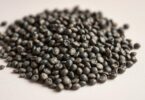Picture this: you’re chopping fresh rosemary for a family recipe, and your curious pup gazes up, nose twitching. Many pet owners face moments like these—unsure whether a common kitchen staple is safe for their furry companion. While this fragrant herb adds flavor to human meals, its role in a canine diet requires thoughtful consideration.
Rosemary, a popular culinary ingredient, often appears in commercial pet foods for its natural preservative properties. Research shows it’s generally non-toxic to canines in small quantities and may even offer health benefits like supporting digestion. However, moderation remains crucial—overconsumption could lead to stomach upset.
Before sharing any human food with your four-legged friend, consulting a veterinarian ensures personalized guidance. This article explores rosemary’s historical uses, nutritional value, and safe preparation methods. You’ll also learn to recognize signs of sensitivity and discover alternative herbs that complement a balanced diet.
Understanding what’s safe for pets empowers owners to make informed choices. By prioritizing your canine’s well-being, you strengthen the bond that makes pet parenthood so rewarding.
Understanding Rosemary’s Profile for Canine Use
Ancient civilizations valued rosemary not just for flavor but for its healing properties. This Mediterranean herb appears in Egyptian tombs and Greek medicinal texts, later becoming a staple in European kitchens. Its needle-like leaves contain fiber and bioactive compounds like carnosic acid, which modern studies link to antioxidant activity.
Historical and Nutritional Background
Originally used to preserve meats before refrigeration, rosemary’s natural antimicrobial qualities made it practical and safe. Fresh sprigs provide small amounts of iron and calcium, while dried versions concentrate the herb’s earthy aroma. Processed forms in commercial pet foods often use extracts to maintain nutritional consistency.
Reported Health Benefits and Common Misconceptions
Some studies suggest rosemary may support immune function and digestive health in pets. However, claims about cancer prevention require more research. A frequent misunderstanding involves dosage—while tiny amounts add flavor, excessive quantities might irritate sensitive stomachs.
The term “rosemary dogs” refers to pets benefiting from controlled herbal additions to meals. Always consult your vet before introducing new ingredients. Balance remains key, as no single herb replaces a complete, species-appropriate diet.
Can Dogs Eat Rosemary? Examining Safety Concerns
When considering herbs for pets, safety takes priority. Fresh rosemary leaves typically pose minimal risk when used sparingly. However, concentrated forms like essential oils demand caution due to higher potency.
Toxicity and Dosage Issues
Fresh or dried rosemary contains carnosol, a compound generally recognized as safe for canines. Veterinarians often recommend limiting intake to ¼ teaspoon per pound of food. Essential oils, though, carry camphor—a substance linked to neurological concerns in sensitive animals.
Pets with epilepsy or kidney conditions should avoid this herb entirely. Always introduce small amounts first, monitoring for reactions over 24 hours. Contact your vet immediately if unusual behaviors like lethargy emerge.
Risks of Overconsumption and Effects on Digestion
Excessive rosemary may irritate the stomach lining, leading to vomiting or diarrhea. These symptoms often resolve within a day but warrant professional advice if persistent. Commercial products using rosemary extracts rarely cause issues due to controlled concentrations.
Store-bought essential oils intended for humans aren’t suitable for pets. Their concentrated nature increases toxicity risks, even in tiny doses. Stick to fresh or dried leaves, finely chopped to prevent choking hazards.
How Rosemary Supports Your Dog’s Health
Modern pet nutrition recognizes rosemary as more than just a flavor enhancer. This versatile herb packs compounds that actively contribute to canine wellness when used correctly. Let’s explore its dual role in promoting vitality and preserving freshness.
Antioxidant and Antimicrobial Properties
Rosemary’s carnosol acts like a cellular bodyguard, neutralizing harmful free radicals. These unstable molecules develop through normal metabolism and environmental exposure. By reducing oxidative stress, the herb supports healthy aging and immune function.
The same components that give rosemary its earthy scent also fight bacteria. Studies show its antimicrobial properties inhibit pathogens like Salmonella in stored pet food. This natural defense helps maintain meal safety between bowl cleanings.
Potential as a Natural Preservative
Many premium kibble brands now use rosemary extract instead of synthetic additives. Its preservative qualities extend shelf life without artificial chemicals. This aligns with growing demand for minimally processed diets.
While research continues on optimal antioxidant dosages, vets agree small amounts in food pose no risk. Fresh leaves offer mild benefits, while dried versions provide concentrated potency. Always combine herbal additions with nutritionally complete meals for balanced canine health.
Incorporating Rosemary into Your Dog's Diet Safely
When adding herbs to dog food, understanding form and quantity is essential. Start with a tiny pinch of fresh or dried leaves mixed into regular meals. This gradual approach helps pets adjust while allowing owners to monitor reactions.
Fresh vs. Dried Leaves: What’s Best?
Fresh rosemary offers a milder flavor and higher moisture content, ideal for homemade recipes. Dried leaves provide concentrated aroma and shelf stability, perfect for sprinkling over kibble. Both forms are safe in moderation—aim for ¼ teaspoon per cup of food.
Essential oils derived from this herb should never enter a pup’s diet. Their potency exceeds safe limits and may trigger adverse effects. Stick to whole leaves or culinary-grade dried versions.
Consult your vet before modifying meals, especially for pets with allergies or chronic conditions. Observe your companion for 24 hours after introducing rosemary. Signs like increased energy or improved digestion indicate positive responses.
Finely chop leaves to prevent choking and mix thoroughly into dog food. Consistent, small doses work better than occasional large amounts. Pair this herb with balanced nutrition to support overall health without overwhelming sensitive stomachs.
Monitoring Your Dog’s Reaction to Rosemary
Introducing new ingredients to your pet’s meals requires attentive observation. While many canines tolerate rosemary well, individual responses vary. Tracking changes in behavior or physical health helps identify potential issues early.
Identifying Early Signs of Digestive Upset
Watch for vomiting or diarrhea within hours of consumption. Some pups may show reduced appetite or stomach discomfort, like pacing or whining. Subtle shifts in energy levels or body language—such as excessive panting—can also signal sensitivity.
Loose stools lasting more than one meal cycle warrant attention. Temporary mild symptoms often resolve quickly, but persistent issues need professional evaluation. Documenting reactions in a journal creates a clear timeline for discussion with your vet.
When to Consult Your Veterinarian
Contact an animal healthcare provider if unusual signs continue beyond 24 hours. Provide details about the amount of rosemary consumed and timing of symptoms. Emergency care becomes necessary if tremors or severe lethargy develop.
Sharing your recorded observations helps vets make accurate assessments. Early intervention prevents minor problems from escalating. Always prioritize professional guidance over online advice for your companion’s safety.
Parting Insights on Harnessing Rosemary for Your Furry Friend
Balancing your dog’s diet with herbal additions demands both enthusiasm and caution. Rosemary stands out as a historically trusted ingredient, now validated by modern research for its antioxidant power and bacteria-fighting qualities. When used sparingly in fresh or dried form, it can enhance meals while supporting overall wellness.
Pet parents should prioritize moderation—a sprinkle of chopped leaves adds vitamins without overwhelming sensitive systems. Always avoid concentrated oils, sticking to culinary-grade forms to keep meals safe for dogs. Track your companion’s response, watching for changes in breath, energy, or digestion after introducing this herb.
Consulting a veterinarian remains non-negotiable before altering diets, especially for pets with health conditions. Small, gradual adjustments allow owners to gauge tolerance while minimizing risks. This measured approach aligns with responsible pet care that blends natural solutions with professional guidance.
Informed choices transform how we nurture our four-legged family members. By staying curious and collaborating with animal health experts, you create a thriving environment where smart nutrition meets tail-wagging vitality.
FAQ
Is rosemary toxic to pets?
Fresh or dried rosemary leaves are generally safe for pets in small amounts. However, concentrated essential oils derived from this herb can cause digestive issues like vomiting or diarrhea if ingested improperly.
What vitamins make rosemary beneficial for canine diets?
The herb contains antioxidants like rosmarinic acid and carnosic acid, which support immune health. It also provides iron, calcium, and vitamin B6, contributing to coat quality and metabolic function.
Can rosemary improve a pet’s skin health?
Yes—its antimicrobial properties may help reduce skin irritation caused by bacteria. Always consult a veterinarian before applying topical treatments containing rosemary extracts.










Leave a Comment